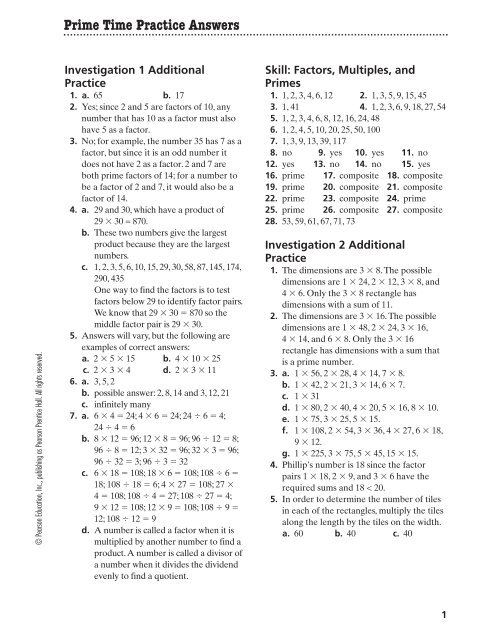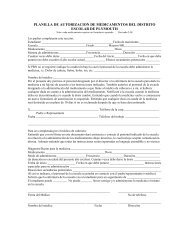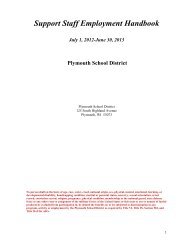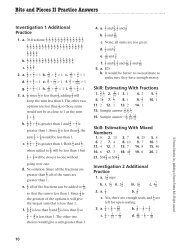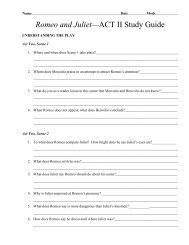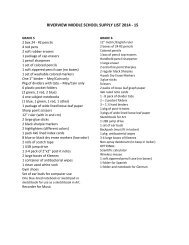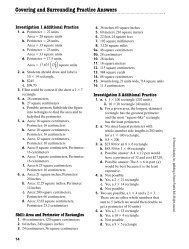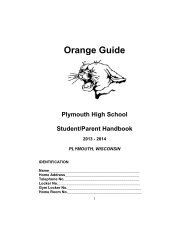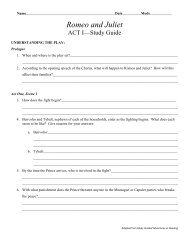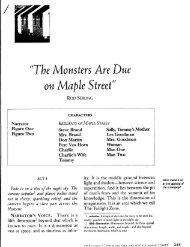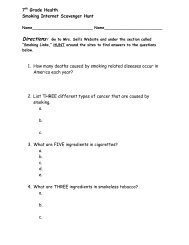Prime Time Practice Answers
Prime Time Practice Answers
Prime Time Practice Answers
You also want an ePaper? Increase the reach of your titles
YUMPU automatically turns print PDFs into web optimized ePapers that Google loves.
<strong>Prime</strong> <strong>Time</strong> <strong>Practice</strong> <strong>Answers</strong>© Pearson Education, Inc., publishing as Pearson Prentice Hall. All rights reserved.Investigation 1 Additional<strong>Practice</strong>1. a. 65 b. 172. Yes; since 2 and 5 are factors of 10, anynumber that has 10 as a factor must alsohave 5 as a factor.3. No; for example, the number 35 has 7 as afactor, but since it is an odd number itdoes not have 2 as a factor. 2 and 7 areboth prime factors of 14; for a number tobe a factor of 2 and 7, it would also be afactor of 14.4. a. 29 and 30, which have a product of29 30 = 870.b. These two numbers give the largestproduct because they are the largestnumbers.c. 1, 2, 3, 5, 6, 10, 15, 29, 30, 58, 87, 145, 174,290, 435One way to find the factors is to testfactors below 29 to identify factor pairs.We know that 29 30 870 so themiddle factor pair is 29 30.5. <strong>Answers</strong> will vary, but the following areexamples of correct answers:a. 2 5 15 b. 4 10 25c. 2 3 4 d. 2 3 116. a. 3, 5, 2b. possible answer: 2, 8, 14 and 3, 12, 21c. infinitely many7. a. 6 4 24; 4 6 24; 24 6 4;24 4 6b. 8 12 96; 12 8 96; 96 12 8;96 8 12; 3 32 96; 32 3 96;96 32 3; 96 3 32c. 6 18 108; 18 6 108; 108 6 18; 108 18 6; 4 27 108; 27 4 108; 108 4 27; 108 27 4;9 12 108; 12 9 108; 108 9 12; 108 12 9d. A number is called a factor when it ismultiplied by another number to find aproduct.A number is called a divisor ofa number when it divides the dividendevenly to find a quotient.Skill: Factors, Multiples, and<strong>Prime</strong>s1. 1, 2, 3, 4, 6, 12 2. 1, 3, 5, 9, 15, 453. 1, 41 4. 1, 2, 3, 6, 9, 18, 27, 545. 1, 2, 3, 4, 6, 8, 12, 16, 24, 486. 1, 2, 4, 5, 10, 20, 25, 50, 1007. 1, 3, 9, 13, 39, 1178. no 9. yes 10. yes 11. no12. yes 13. no 14. no 15. yes16. prime 17. composite 18. composite19. prime 20. composite 21. composite22. prime 23. composite 24. prime25. prime 26. composite 27. composite28. 53, 59, 61, 67, 71, 73Investigation 2 Additional<strong>Practice</strong>1. The dimensions are 3 8. The possibledimensions are 1 24, 2 12, 3 8, and4 6. Only the 3 8 rectangle hasdimensions with a sum of 11.2. The dimensions are 3 16. The possibledimensions are 1 48, 2 24, 3 16,4 14, and 6 8. Only the 3 16rectangle has dimensions with a sum thatis a prime number.3. a. 1 56, 2 28, 4 14, 7 8.b. 1 42, 2 21, 3 14, 6 7.c. 1 31d. 1 80, 2 40, 4 20, 5 16, 8 10.e. 1 75, 3 25, 5 15.f. 1 108, 2 54, 3 36, 4 27, 6 18,9 12.g. 1 225, 3 75, 5 45, 15 15.4. Phillip’s number is 18 since the factorpairs 1 18, 2 9, and 3 6 have therequired sums and 18 < 20.5. In order to determine the number of tilesin each of the rectangles, multiply the tilesalong the length by the tiles on the width.a. 60 b. 40 c. 401
<strong>Prime</strong> <strong>Time</strong> <strong>Practice</strong> <strong>Answers</strong>6. a.51476Factors of 12 Factors of 134231281 131510b. 1 is the only number in the intersectionsince 13 is a prime number.c. <strong>Answers</strong> will vary; examples includefactors of two different prime numbers(e.g., 5 and 13) or factors of twodifferent relatively prime numbers (e.g.,11 and 14).7. a.25Multiples of 5 Multiples of 25351510203040b. The numbers in the intersection arethe multiples of 10, which is 5 2.Every number that is a multiple of10 must have 5 and 2 as factors since5 2 10.c. 75 would be placed with the multiplesof 5 since it is a multiple of 5 but not amultiple of 2. 90 would be placed in theintersection since it is a multiple ofboth 5 and 2.9112 4 681214 1618 22 2428 32 34 3638268. The fourth number is even. Since the firstthree numbers were even, odd, and odd,respectively, the sum of these three will beeven. Thus, an even number must beadded to this even sum to produce aneven number.Investigation 3 Additional<strong>Practice</strong>1. a. Susan shouldn’t have to wait at all.The #14 bus should arrive at the mallat 10 A.M. and the #11 bus shouldleave the mall for the museum atabout 10 A.M. (since the #11 bus runsevery 12 minutes, it leaves at the top ofevery hour).b. Susan will have to wait 12 minutesbecause the #14 bus should arrive atnoon.c. Both buses are at the mall at 9 A.M.,10 A.M., 11 A.M., and noon because theleast common multiple of 15 and 12 is60.2. a. One rectangle is made with 42 tiles, andthe other is made with 56 tiles.Theseare the only two even multiples of7 between 40 and 60.b. The rectangle with 42 tiles has a lengthof 6, and the rectangle with 56 tiles has alength of 8.These answers are found byfinding the other number in the factorpair with 7 for each rectangle.c. Students’ answers will vary. For 42: 1 42, 2 21, or 3 14. For 56: 1 56, 2 28, or 4 14.3. Jack will only have a conflict one day permonth on the 21 st .The least commonmultiple of 3 and 7 is 21. The nextcommon multiple, 42, is greater than thenumber of days in a month.4. a. Since the numbers are prime, they don’thave any proper factors other than 1.Therefore, their least common multiplewould be their product.© Pearson Education, Inc., publishing as Pearson Prentice Hall. All rights reserved.2
<strong>Prime</strong> <strong>Time</strong> <strong>Practice</strong> <strong>Answers</strong>© Pearson Education, Inc., publishing as Pearson Prentice Hall. All rights reserved.b. Since the numbers are prime, the onlyfactors each number has is 1 and itself.Therefore, the greatest common factormust be 1.5. a. LCM: 24; GCF: 4b. LCM: 105; GCF: 1c. LCM: 187; GCF: 1d. LCM: 108; GCF: 36e. Parts (b) and (c); for part (b), the twonumbers are relatively prime. For part(c), the two numbers are prime.6. a. 4 b. 5 c. 10 d. 25e. The greatest common factor of twonumbers is one of the two numberswhen the smaller number is a factor ofthe larger number.Skill: Least Common Multiple1. 10 2. 6 3. 24 4. 12 5. 406. 30 7. 60 8. 24 9. 45 10. 3011. 18 12. 18 13. 15 14. 20 15. 6316. 28 17. at 1:30 P.M.Skill: Greatest Common Factor1. 4 2. 9 3. 1 4. 17 5. 126. 6 7. 5 8. 5 9. 5 10. 2511. 7 12. 3 13. 8 14. 5 15. 116. 5 17. 18Investigation 4 Additional<strong>Practice</strong>1. a. 630 2 3 3 5 7b. 144 2 2 2 2 3 3c. 1,011 337 3 d. 133 7 19e. 23 is prime.2. a.EnterMaze 9242 3 7 26 2 7 115 4 9 10Exitb.c.d.EnterMaze 1,0802 8 6 327 5 7 22 5 2 9Maze 38,220Exit14 39 70 91Enter 7 2 20 6042 15 2 298 26 13 7 ExitMaze 2103 10 3 14Enter 2 3 5 735 2 105 27 15 6 3Exit3. a. GCF 5, LCM 525b. GCF 27, LCM 81c. GCF 9, LCM 2524. 105; an odd number cannot have a factorof 2, and 3, 5, and 7 are the only threeprimes with a product less than 160.5. 1,8006. a. Possible answer: 6 and 36b. Possible answer 12 and 60c. The least common multiple is the othernumber in the pair.7. a. Yes, the only common factor they haveis 1.b. Yes, the only common factor they haveis 1.c. No, even numbers always have a factorof 2.d. Make sure that all the factors of thesecond number differ from the first(except for 1).3


